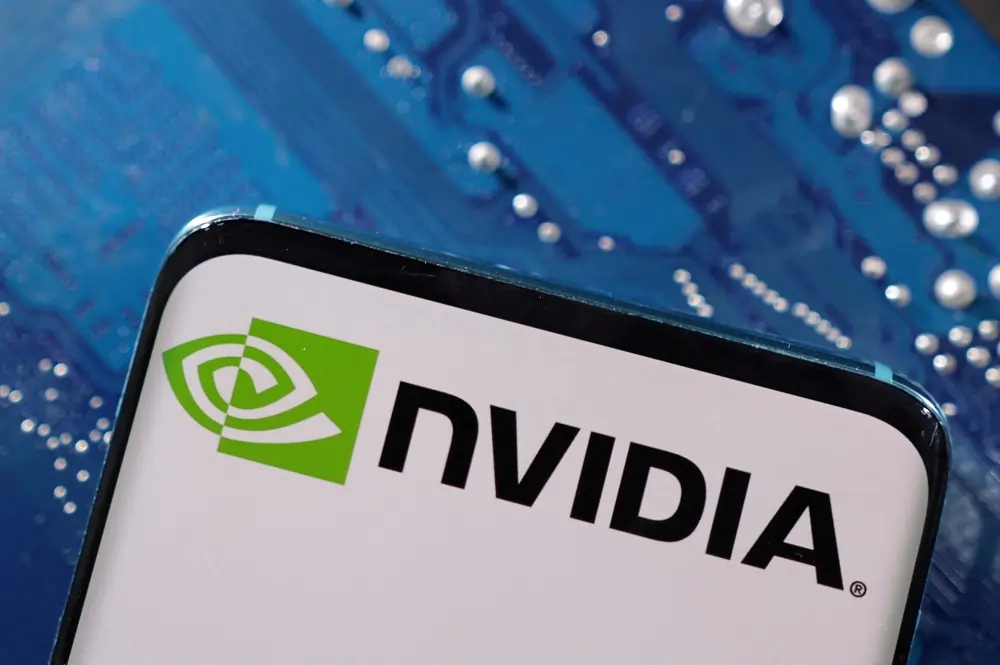
By Noel Randewich, Saqib Iqbal Ahmed and Deborah Mary Sophia
(Reuters) – Nvidia shares were down about 2% in early trading on Thursday, paring some premarket losses as investors stayed confident about the chip giant’s growth prospects despite a forecast that fell short of lofty expectations.
The stock had fallen more than 5% before the bell after Nvidia on Wednesday forecast third-quarter gross margins that could miss market estimates and revenue that was largely in line.
Some investor concerns were allayed after the company said it expects production of its next-generation Blackwell chips to ramp up in the fourth quarter.
The stock’s recovery also lifted shares of other chip companies such as Broadcom, Advanced Micro Devices and Arm, which were up between 1.9% and 2.8%.
Nvidia has crushed Wall Street’s estimates for several quarters on surging demand for AI chips, leading investors to bank on the company’s penchant for routine blowout forecasts. The stock’s strength has been a pillar of the market’s rally through both this year and the past year – leading to what some say are ultimately insurmountable forecasts.
“They beat but this was just one of those situations where expectations were so high. I don’t know that they could have had a good enough number for people to be happy,” said JJ Kinahan, CEO of IG North America and president of online broker Tastytrade.
The forecast followed strong second-quarter earnings that topped Wall Street expectations, and the AI bellwether announced a new $50 billion share buyback as well.
“Investors want more, more and more when it comes to Nvidia,” said Dan Coatsworth, investment analyst at AJ Bell.
“It looks like investors might not have taken the average of analyst forecasts to be the benchmark for Nvidia’s performance, instead they’ve taken the highest end of the estimate range to be the hurdle to clear.”
Nvidia forecast revenue of $32.5 billion, plus or minus 2%, for its fiscal third quarter, compared with analysts’ estimates of $31.8 billion, according to LSEG data. That revenue forecast implies 80% growth from the year-ago quarter, but was below the top-end of market estimates at $37.90 billion.
BUYING OPPORTUNITY
Some analysts saw the dip as a buying opportunity.
“Nvidia has had much bigger drawdowns on (earnings) reports … we think the selloff is an opportunity to accumulate the stock,” said Nancy Tengler, CEO of Laffer Tengler Investments.
Big Tech stocks shrugged off the weakness, a sign that investors did not see the report as a bad sign for the AI boom. Alphabet, Meta Platforms, Amazon.com and Apple were all up between 1.2% and 2%.
“The long-term AI story is still sort of intact. It’s just a bit of a relief that the numbers weren’t disastrous,” said Ben Barringer, analyst at Quilter Cheviot.
Worries about slow payoffs from hefty AI investments have dogged large technology companies in recent weeks, with shares of Microsoft and Alphabet trading lower since their quarterly reports last month.
A delay in the production ramp-up of Nvidia’s next-generation Blackwell chips until the fourth quarter was not a big concern, analysts said, with the company seeing strong demand for its current-generation Hopper chips.
However, some analysts were worried about rising regulatory scrutiny after Nvidia also disclosed requests for information from U.S. and South Korean regulators, adding to inquiries from the EU, UK and China previously.
“After the DOJ win over Google, large-cap tech has got to be more cognizant of regulatory intervention … historically, the threat was a little bit toothless. But now that they’ve got this win over Google,” Barringer said.
The lackluster response to Nvidia’s earnings report could help set the tone for market sentiment heading into what is historically a volatile time of the year. The S&P 500 has fallen in September by an average of 0.8% since World War Two, the worst performance of any month, according to CFRA data.
Nvidia’s stock dropped 2.1% in Wednesday’s session, ahead of its report. It remains up about 150% so far in 2024, making it the biggest winner in Wall Street’s AI rally.
The stock was valued at 36 times earnings ahead of its quarterly report, inexpensive compared to its average of 41 over the past five years. The S&P 500 is trading at 21 times expected earnings, compared to a five-year average of 18.
(Reporting by Noel Randewich in San Francisco, Saqib Ahmed in New York and Deborah Sophia in Bengaluru; Additional reporting by Aditya Soni, Kanchana Chakravarty and Medha Singh; Editing by Ira Iosebashvili, Lisa Shumaker, Mark Potter, Saumyadeb Chakrabarty and Shounak Dasgupta)


